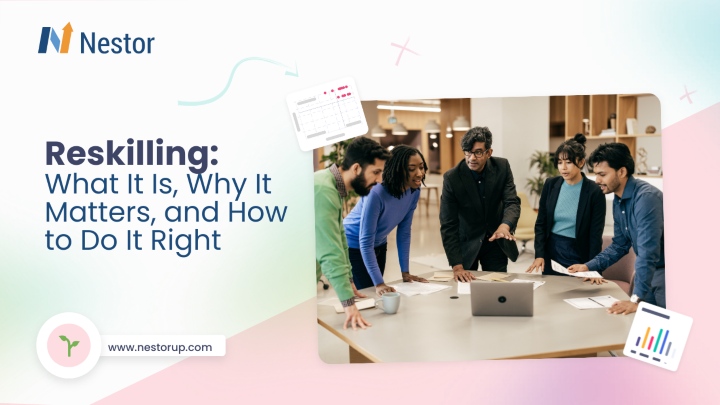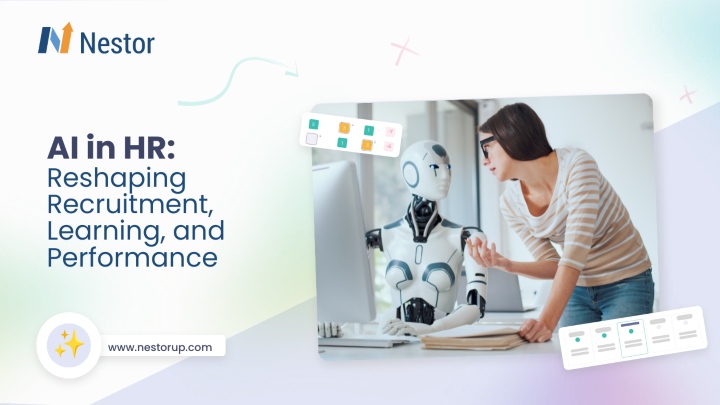
Contents
A manufacturing plant fails to find technicians. A tech company’s AI positions sit empty. A healthcare facility can’t staff critical roles. This isn’t a future problem; the skills shortage affects every sector now.
While executives plan strategies and HR teams adjust recruitment, the gap between available talent and required skills grows wider daily.
The crisis runs deeper than candidate scarcity. It reveals a mismatch between economic needs and the current talent pool. Companies compete for qualified professionals, missing both untapped potential and new skill requirements.
“We’ve handled talent shortages before,” you might say. But this time it’s different. The combination of tech advancement, demographic shifts, and industry changes has created unprecedented challenges.
Standard talent acquisition methods fall short. While businesses chase immediate hiring needs, they overlook the systemic changes needed in workforce development.
Want to know the real drivers behind this crisis? Curious why your old solutions aren’t working anymore? Skeptical about whether this affects your industry? Let’s examine the facts about the skills shortage – they might surprise you.
What Is a Skills Shortage?
A skills shortage describes a situation in which the supply of (specialized) skilled employees fails to meet the demand within a specific industry or sector. Or, in other words, it’s when there aren’t enough people available — who possess the necessary and desirable skills and proficiency — to fill job vacancies.
This gap affects industries worldwide. Companies struggle to hire for critical positions, delaying projects and increasing costs. At the same time, employees miss opportunities because they lack the skills businesses need.
And with the global talent shortage at a 16-year-high, researchers predict an 85 million person shortage by 2030—roughly equivalent to the current population of Turkey. The impact is significant and it’s not slowing down anytime soon.
A skills shortage is different from a skills gap. A shortage means too few skilled workers are available. A gap means workers are available, but their skills don’t match the job requirements. Simply put, those deficiencies prevent workers from performing at an expected or high level.
What Are the Main Causes of the Skills Shortage?
Disruptive Technological Advancements
One of the main factors behind the current skills shortage is the ongoing development and adoption of emerging tech solutions. New skills are required to operate them — or at least a combination of existing and new abilities — and this often results in a shortage of workers with the necessary technical or digital expertise.
Let’s look at generative AI as an example. ChatGPT was launched not even 2 years ago (at the time of writing this article), and we’re already seeing job descriptions that list skills associated with it, like the ability to write effective prompts and diligently check the validity of the output.
Being such a game-changing and rapidly evolving technology, it’s virtually impossible to shift educational systems (which are typically slow to adapt) in a way that prepares students for this new world of work, although some academic institutions have already started.
The natural outcome (as we’ll explore in more detail later) is that businesses will need to encourage and support their workforce to develop this type of skill since it cannot be found externally — and for which the competition will be massive.
Inevitable Demographic Shifts
Another factor driving the skills shortage is a combination of aging populations and declining birth rates. Let’s look at some actual examples. According to William Howard, Director of HR Research and Advisory Services at McLean & Company:
“22% of Canadians aged 55-59 reported they were retired. For those aged 60-64, that increases to 45%. For those aged 65-69, that increases to over 80%. With such a large proportion of our workforce in these age brackets (in the US, almost 1 in 4 people in the labor force were 55 or older), we are seeing a staggering knowledge and skills drain as these people retire.”
This leaves employers in a very challenging situation: not only are their experienced workers retiring but there also aren’t enough (young) people stepping up to replace them. It’s a situation that will only worsen, especially in Western countries, if we look at these types of statistics.
When it comes to workforce demographics, smaller nations face a different type of challenge: the brain drain phenomenon. They often invest in nurturing and educating high-potential individuals only to see them leave for (usually Western) countries with more favorable professional opportunities and higher living standards.
Declining Workforce Participation
The number one factor behind the skills shortage is the declining labor participation due to a variety of reasons, such as access to childcare, substance abuse, shifting family values, few(er) college graduates, government programs and policies, and other employment barriers.
— Shannon M. Burkel, Chief Client Officer at Axios HR

While this problem will affect certain countries and economies more than others, it’s clear that increased inequality, inadequate access to education and training, as well as a rise in chronic health conditions and disabilities directly impact the well-being, quality, and quantity of skilled workers.
The US Chamber of Commerce further stresses that while “the most recent jobs report from the Bureau of Labor Statistics indicates that thousands of individuals are joining the workforce, which is good, labor force participation still does not match what it was before the pandemic for a variety of reasons.”
The Chamber goes on to explain that “younger respondents, aged 25-34, are prioritizing personal growth over searching for a job right now, with 36% saying they’re more focused on acquiring new skills, education or training before re-entering the job market.”
Misplaced Skills Investment
Another important factor behind the skills shortage is according to William Howard, Director of HR Research and Advisory Services at McLean & Company a misplaced skills investment.
Organizations have focused too much on teaching skills for HOW work is done and underinvested in teaching skills around understanding WHY work is done.
— William Howard, Director of HR Research & Advisory Services McLean & Company

Why does this matter? Because “skills that focus on how to do a specific task (e.g., which buttons to press on a machine) only last if that specific task doesn’t change. In today’s world, how we do tasks changes rapidly, whether it’s a new machine in a factory or a new process or enterprise system.“
Soft or relational skills, such as business acumen, the ability to learn, communication, or resilience, will help employees thrive while learning new skills. These soft skills are also less likely to become obsolete than task-level skills.
— William Howard, Director of HR Research & Advisory Services McLean & Company

As a direct consequence of this misplaced skills investment, while one in two non-office workers are highly proficient at task or functional skills, just one in four are highly proficient in things like organizational or leadership skills, according to research from McLean & Company.
A Mismatch Between Education and Skill Needs
The mismatch between the skills taught in traditional educational institutions and those demanded by employers further exacerbates the skills shortage problem. This mismatch can manifest in several ways:
- too much emphasis on technical or hard skills and not enough on soft or human skills, which are becoming more important than ever in the new AI-driven world
- lack of exposure to emerging technologies and practices that are in high demand by employers
- not enough practical skills or the inability to translate academic knowledge into real-world application
These gaps exist because different education providers tend to focus strongly on specific learning outcomes, instead of thinking holistically about a learner’s journey. Individuals typically enroll in education programs to get the skills they need to be successful at work. But they also need a pathway or plan that’s going to help them continue to advance and grow over the course of their career.
— Peter DeVries, CEO at Modern Campus

This is one of the reasons why some organizations, including giants like Google, started to eliminate the requirement for college or university degrees for various jobs and switched to skills-based hiring instead. It is yet another proof that skills alone are a better predictor of performance in a job role rather than formal education.
An increased cooperation between the public (government, education) and private sectors (businesses and organizations) will be needed in order to realign educational goals and curricula with the current and especially the future skill needs.
What the 70-20-10 Model Reveals
The mismatch between the skills taught in traditional institutions of education is further emphasized by various research like the famous 70-20-10 learning and development model, which states that only 10% of learning comes from formal or traditional methods, while 70% happens in the flow of work (experiential learning) and 20% through interactions with others (social learning).
For the 70-20-10 model to work, employers need to play an active role and provide opportunities for learning and development in the flow of work as well as encourage their people to make the most out of them.
It’s also important to look at the skill needs and trends in your industry to decide the direction of these development initiatives and ensure that the new abilities are applicable in the real world and prevent the emergence of future gaps and shortages.
But all these initiatives have little effect if people don’t get the chance to put into practice and exercise the skills they’ve learned, according to Teresa Rose, an award-winning learning and performance consultant.
What evidence have you got that people have been able to use that skill as knowledge and do something with it? You could just gather lots of skills, but what are you actually doing with that skill to impart the knowledge and create some form of value?
— Teresa Rose, Award-Winning Learning and Performance Consultant & Founder of ConsultHer Ltd

Industry-Specific Developments
For some industries, a skills shortage can emerge due to unique challenges or requirements. For example, the transition to sustainable development and sustainability goals has led to a tremendous increase in the demand for green skills — with manufacturing, energy, operations, and IT being among the most affected sectors.
As environmental regulations and standards keep evolving, businesses will need to step up their efforts to adapt both their practices and their employees, with the latter needing to undergo either upskilling or reskilling in order to remain valuable within the organization.
According to LinkedIn’s Global Green Skills Report 2023, more and more companies are looking to hire people with green skills, especially in industries like electric vehicle manufacturing, batteries, or green energy. “But the issue is that the number of people with green skills remains about one in eight and one in nine in Europe,” shares Allen Blue, co-founder of LinkedIn in an interview for Euronews.
The Impact of the Skills Shortage
By 2030, more than 85 million jobs could go unfilled because there aren’t enough skilled people to take them. That talent shortage could result in about $8.5 trillion in unrealized annual revenues.
— Korn Ferry
The skills shortage is more than just a workforce challenge. It is an issue that threatens global economic stability and organizational success. The global skills shortage could cost businesses $8.5 trillion in lost annual revenue by 2030. This threat spans continents and industries, hitting both developed and emerging markets.
Countries such as Japan, Indonesia, and Brazil are expected to face the most significant talent deficits, with an anticipated 18 million person shortage in each of these nations by 2030. China, which has long been considered the world’s manufacturing powerhouse, follows closely with a projected 12 million person shortage.
The United States and Russia are also facing talent shortages, with a projected 6 million person deficit each. These countries represent critical global economies, and their inability to meet demand for skilled labor could ripple throughout global markets, affecting industries and international trade.
Despite these alarming statistics, businesses are still unprepared for the scale of workforce disruption. Research shows that two out of three companies are not equipped to manage the impact of technological advancements and shifting market trends on the workforce.
The consequences of the skills shortage extend beyond immediate workforce challenges and ripple through various aspects of business operations, affecting efficiency, innovation, customer satisfaction, and financial stability.
Core Business Challenges
Innovation and Growth
- Innovation suffers when teams focus on filling gaps rather than creating solutions
- Companies lose market share as competitors move ahead with fresh ideas
- Product development slows without specialized technical skills
- Research and development projects stall or get canceled
Operational Efficiency
- Productivity drops through workflow bottlenecks and delays
- Teams stretch thin covering missing skills, leading to mistakes
- Project timelines extend as managers struggle to staff key roles
- Quality control issues increase across operations
Employee Impact
- Worker burnout rises as staff handle extra responsibilities
- Job satisfaction decreases when training opportunities lag
- Stress levels climb from constant understaffing
- Career growth stalls without proper skill development paths
Leadership and Development
- Companies struggle to identify and grow future leaders
- Succession planning gaps create uncertainty
- Mentorship programs suffer from lack of qualified mentors
- Training programs fall behind industry needs
Customer Relations
- Service quality drops when teams lack crucial skills
- Response times lengthen due to staff shortages
- Customer satisfaction decreases
- Brand reputation risks increase
Financial Consequences
- Recruitment costs rise in competitive markets
- Temporary staffing expenses strain budgets
- Training costs increase for emergency skill development
- Revenue drops from missed opportunities
- Project delays create budget overruns
Team Dynamics
- Morale suffers in understaffed departments
- Collaboration decreases under increased workloads
- Communication breaks down between overworked teams
- Internal conflicts rise from uneven workload distribution
Diversity and Inclusion
- Rigid skill requirements limit talent pools
- Companies miss opportunities to build inclusive teams
- Innovation suffers from lack of diverse perspectives
- Market understanding narrows with homogeneous teams
Market Position
- Competitive advantage weakens without key skills
- Market opportunities slip away due to capability gaps
- Industry leadership position risks decline
- Growth potential shrinks in new markets
Long-term Strategic Impact
- Digital transformation efforts stall
- Market adaptation slows significantly
- International expansion plans face delays
- Research and development capacity diminishes
The skills shortage demands immediate action. Organizations must rethink their approach to talent development and workforce planning. Those who adapt quickly will gain significant advantages in their markets.
The Current State of the Skills Shortage
Let’s look at some insights, and predictions for different regions around the globe to better understand the current state and trajectory of the skills shortage.
The United States
In the US, “when taking a look at the labor shortage across different industries, the education and health services sector, and the professional and business services sector, consistently exhibit the highest number of job openings”, according to the US Chamber of Commerce.
It’s important to highlight that professional and business services include a wide range of jobs, such as:
- legal services
- scientific research
- landscaping workers
- cleaners
As far as manufacturing is concerned, an estimated 2.1 million jobs could go unfilled by 2030, according to the Manufacturing Institute.
The financial impact of these shortages shouldn’t be overlooked either. By 2030, the United States could experience unrealized revenue of $1.748 trillion due to labor shortages, equivalent to 6% of its entire economy based on Korn Ferry data.
Europe
In Europe, “almost half (42%) of SMEs indicated they faced skills shortages, a particularly problematic situation for the industry sector and manufacturing”, according to the European Commission.
Insights from Korn Ferry also reveal that due to severe skills shortages, the unrealized output of the EU countries included in their study could total $1.323 trillion by 2030, with the financial and business services sector among the most affected.
Australia
36% of occupations assessed are in (skills) shortage, according to the latest data from Jobs and Skills Australia. The highest shortages are experienced by:
- technicians and trade workers
- jobs in information communication technology (ICT)
- science roles
This data shows an increase in skills shortages over the last 3 years and reveals that either there aren’t enough skilled people available or the ones who have those desirable skills aren’t willing to get employed under the existing pay and working conditions.
The same study from Korn Ferry points out that Australia, like other countries impacted by the skills shortage, will be affected financially, with a potential unrealized output of $587.56 billion by 2030.
What Industries Have the Most Skill Shortages?
Skill shortages continue to challenge employers across various industries, making it harder to fill open positions. A report from the Society for Human Resource Management (SHRM) highlights that a low number of applicants is one of the biggest obstacles in hiring qualified professionals.
Data from the Bureau of Labor Statistics (BLS) further supports these findings, showing that as the unemployment rate decreases, job openings increase, leading to significant talent shortages in many fields.
Top Industries Facing the Biggest Skill Shortages
According to SHRM, the health care, social assistance, and manufacturing industries are experiencing the highest levels of recruiting difficulty. Here’s a closer look at the industries and roles most affected:
1. Health Care & Social Assistance
- Why the shortage? The health care industry is one of the fastest-growing sectors, with an increasing demand for medical professionals due to aging populations and advancements in medical technology.
- Most in-demand jobs:
- Nurses, doctors, and medical specialists
- Community and social service workers (counselors, therapists, social workers)
2. Manufacturing
- Why the shortage? Many skilled trades require extensive training and apprenticeships, but fewer young workers are entering these professions. Specific industries, like cement and concrete product manufacturing and plywood manufacturing, are expected to grow rapidly.
- Most in-demand jobs:
- Skilled trades: electricians, carpenters, machinists, mechanics, welders, and plumbers
3. Engineering & Architecture
- Why the shortage? The demand for engineers and architects is rising due to infrastructure projects and technological advancements, but there aren’t enough qualified professionals to fill these roles.
- Most in-demand jobs:
- Civil, mechanical, electrical, and software engineers
- Architects
4. IT & Computer Science
- Why the shortage? The digital economy continues to expand, but companies struggle to find skilled IT professionals with expertise in programming, cybersecurity, and data analytics.
- Most in-demand jobs:
- IT analysts, software developers, programmers
- Database administrators
5. Skilled Technicians
- Why the shortage? Technicians in various fields require specialized training, but fewer candidates are entering technical education programs.
- Most in-demand jobs:
- Health technicians
- Telecommunications and environmental technicians
6. Transportation & Logistics
- Why the shortage? With the rise of e-commerce and global supply chain demands, the need for skilled drivers and logistics professionals has grown. However, the industry struggles with an aging workforce.
- Most in-demand jobs:
- Truck drivers
- Supply chain specialists
7. Construction & Extraction (Mining, Oil, and Gas)
- Why the shortage? A decline in vocational training programs and fewer young professionals entering these fields have led to a labor shortage.
- Most in-demand jobs:
- Miners, drillers, and construction workers
8. Science & Mathematics
- Why the shortage? STEM (Science, Technology, Engineering, and Mathematics) fields are rapidly growing, but there’s a lack of skilled workers, particularly in research and specialized scientific areas.
- Most in-demand jobs:
- Scientists, data analysts, statisticians
9. Executive Leadership
- Why the shortage? As companies grow, they need experienced leaders, but finding executives with the right mix of leadership and industry expertise is challenging.
- Most in-demand jobs:
- CEOs, CFOs, and other C-suite executives
The increasing demand for skilled professionals across these industries suggests that upskilling and reskilling will be crucial for both workers and employers.
Strategies to Overcome the Skills Shortage
Looking at all these numbers and predictions, it’s fair to say that we already are or we’ll soon face a skill crisis in the true sense of the word.
So, what can your organization do to prevent and limit the impact of the skills shortage? Well, as highlighted by Shannon M. Burkel, Chief Client Officer at Axios HR:
Employers need to be part of the solution. They are not the entire solution, but in the short term, they need to evaluate how the work gets done and get creative.
— Shannon M. Burkel, Chief Client Officer at Axios HR

But what does this mean in practice for modern organizations?
Investing in skill development
Instead of looking for skills that are hard to find or hire, building these abilities internally should be considered a potential solution.
Whether it’s upskilling or reskilling, both are viable and effective answers to the current skills shortage and can act as preemptive measures against additional shortages in the future. However, the focus of internal skill development programs should be on the long-term:
Development for the short-term means teaching only those skills required to do the tasks at hand and no more. Development for the long-term means teaching skills that may not pay off immediately but will reap benefits in the future. This includes teaching learning skills, resilience, communication, and more.
— William Howard, Director of HR Research & Advisory Services McLean & Company

It’s a long-term process, that should begin with identifying the short- and long-term skill needs of your company as well as the relevant skill trends in your industry. Then, you need to evaluate the current skill level of your workforce and decide the areas or gaps that are most urgent.
Learn more about skills management and development.
Skill development through knowledge transfer
When it comes to skill development, one thing that not enough organizations prioritize is providing opportunities and encouraging future retirees to pass on their skills and knowledge to their peers.
William Howard explains that “this can happen through both formal and informal mentorship, coaching, or sponsorship programs, dedicated knowledge transfer programs, or by having retirees phase out of the workforce slowly.“
And while a good example of this would be enabling people planning to retire to continue working part-time for some time, this isn’t something most organizations are currently offering, according to William.
Also, having a well-designed succession planning process might help in this direction.
Rethinking the recruitment process
We can look at this from two different perspectives. The first one involves switching to skills-first hiring, which means the focus is no longer on qualifications but on skills — regardless of how candidates acquire them. This will instantly expand your talent pool.
Another is to accept that the current skills shortage cannot be (entirely) solved by hiring, especially with top talent being in high demand. So, the focus could change on recruiting people who display the right potential and the necessary attitude and helping them develop the skills you desire.
Both approaches involve a shift, especially in mindset, regarding how and who should be considered during the recruitment process — but it will pay off in the long run.
Check out the skills-first framework for talent hiring, development, and redeployment.
Enhancing the employee experience
As highlighted earlier by data from Jobs and Skills Australia, skills shortages could also mean highly skilled individuals are available but they aren’t attracted by the current offerings on the job market.
Organizations need to rethink the job descriptions and even the way work gets done in order to meet the expectations of modern candidates — especially those from younger generations who value work-life balance and general well-being much more.
Of course, that’s only one aspect of the employee experience. Having a flexible approach (hybrid or remote), providing desirable growth opportunities, and embracing non-linear career paths and internal mobility are just as important.
Final thoughts
Like other issues in the modern work landscape, the skills shortage presents a multifaceted challenge whose far-reaching implications don’t affect only businesses and workers, but economies across the globe.
As our industries keep evolving (e.g., the transition to sustainability goals) and cutting-edge technologies reshape the nature of work itself, addressing the skills shortage is increasingly urgent, and failing to do so will result in a skills crisis in the very near future.
Investing in upskilling and reskilling, developing a culture of continuous learning, and tightening the collaboration between the public and private sectors will become essential to building a resilient workforce and sustainable organizations.
Frequently Asked Questions (FAQs) About the Skills Shortage
What is a skills shortage?
A skills shortage occurs when the demand for employees with specific skills exceeds the available supply within a particular industry or sector. This means there aren’t enough qualified individuals to fill open positions.
How does a skills shortage differ from a skills gap?
While both terms relate to discrepancies in workforce competencies, a skills shortage refers to a lack of available candidates with the necessary skills. In contrast, a skills gap indicates that, although there are enough candidates or employees, their current skill sets do not meet the requirements of their roles.
What are the primary causes of the current skills shortage?
The main factors contributing to the current skills shortage include:
- Disruptive Technological Advancements: Rapid development and adoption of new technologies require new skills, leading to a shortage of workers with the necessary technical or digital expertise.
- Demographic Shifts: Aging populations and declining birth rates result in a smaller workforce, exacerbating the shortage of skilled employees.
How do you deal with the skills shortage?
Some of the ways to deal with the skills shortage is to begin prioritizing the internal development of highly specialized or highly desirable skills — through upskilling and reskilling programs — and to switch to skills-first hiring, which will open up newer and wider pools of talent.
What skills do most people lack?
Skills shortages and skills gaps vary from one industry or company to another. For example, the healthcare sector faces both hard and soft skill shortages, while the engineering, manufacturing, and agriculture fields are mainly dealing with technical skills shortages.
However, regardless of industry, both employees and employers should prioritize the development of soft or human skills, since their importance will grow exponentially as automation and AI are adopted at a large scale.
Which industries are most affected by the skills shortage?
Industries such as technology, healthcare, manufacturing, and engineering are among the hardest hit, as they require specialized skills that are in high demand but short supply.










